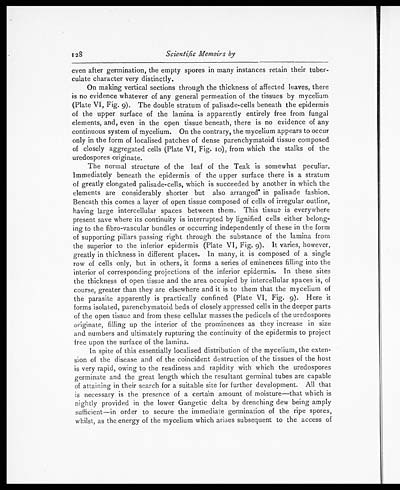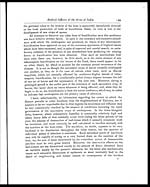Medicine - Institutions > Army health reports and medical documents > Scientific memoirs by medical officers of the Army of India > Part X, 1897 > 5 - On certain diseases of fungal and algal origin affecting economic plants in India
(149) Page 128
Download files
Individual page:
Thumbnail gallery: Grid view | List view

128
Scientific Memoirs by
even after germination, the empty spores in many instances retain their tuber-
culate character very distinctly.
On making vertical sections through the thickness of affected leaves, there
is no evidence whatever of any general permeation of the tissues by mycelium
(Plate VI, Fig. 9). The double stratum of palisade-cells beneath the epidermis
of the upper surface of the lamina is apparently entirely free from fungal
elements, and, even in the open tissue beneath, there is no evidence of any
continuous system of mycelium. On the contrary, the mycelium appears to occur
only in the form of localised patches of dense parenchymatoid tissue composed
of closely aggregated cells (Plate VI, Fig. l0), from which the stalks of the
uredospores originate.
The normal structure of the leaf of the Teak is somewhat peculiar.
Immediately beneath the epidermis of the upper surface there is a stratum
of greatly elongated palisade-cells, which is succeeded by another in which the
elements are considerably shorter but also arranged in palisade fashion.
Beneath this comes a layer of open tissue composed of cells of irregular outline,
having large intercellular spaces between them. This tissue is everywhere
present save where its continuity is interrupted by lignified cells either belong-
ing to the fibro-vascular bundles or occurring independently of these in the form
of supporting pillars passing right through the substance of the lamina from
the superior to the inferior epidermis (Plate VI, Fig. 9). It varies, however,
greatly in thickness in different places. In many, it is composed of a single
row of cells only, but in others, it forms a series of eminences filling into the
interior of corresponding projections of the inferior epidermis. In these sites
the thickness of open tissue and the area occupied by intercellular spaces is, of
course, greater than they are elsewhere and it is to them that the mycelium of
the parasite apparently is practically confined (Plate VI, Fig. 9). Here it
forms isolated, parenchymatoid beds of closely appressed cells in the deeper parts
of the open tissue and from these cellular masses the pedicels of the uredospores
originate, filling up the interior of the prominences as they increase in size
and numbers and ultimately rupturing the continuity of the epidermis to project
free upon the surface of the lamina.
In spite of this essentially localised distribution of the mycelium, the exten-
sion of the disease and of the coincident destruction of the tissues of the host
is very rapid, owing to the readiness and rapidity with which the uredospores
germinate and the great length which the resultant germinal tubes are capable
of attaining in their search for a suitable site for further development. All that
is necessary is the presence of a certain amount of moisture—that which is
nightly provided in the lower Gangetic delta by drenching dew being amply
sufficient—in order to secure the immediate germination of the ripe spores,
whilst, as the energy of the mycelium which arises subsequent to the access of
Set display mode to: Large image | Zoom image | Transcription
Images and transcriptions on this page, including medium image downloads, may be used under the Creative Commons Attribution 4.0 International Licence unless otherwise stated. ![]()
| Permanent URL | https://digital.nls.uk/75003501 |
|---|
| Shelfmark | IP/QB.10 |
|---|---|
| Additional NLS resources: | |




